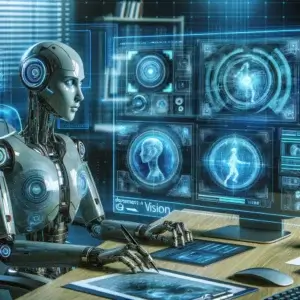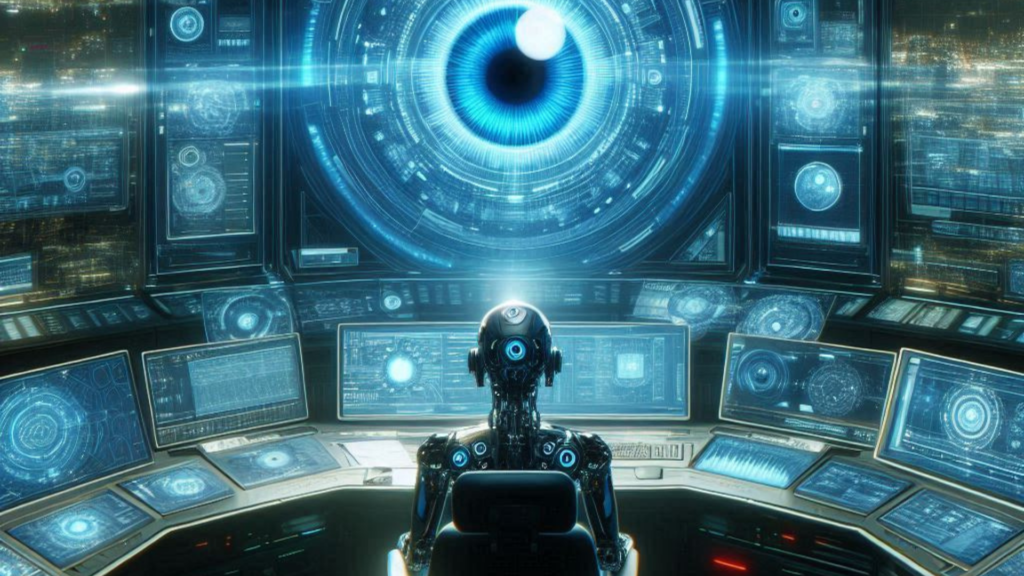Table of Contents
ToggleExploring ChatGPT 4 Vision: Transforming AI Interaction with Advanced Image Understanding Capabilities
This guide is your one-stop shop to learn all about ChatGPT 4 Vision. It covers everything from how to get started, to using it in real-life examples, and understanding its limitations. GPT-4 Vision is the latest big thing from OpenAI, launched alongside ChatGPT. It’s a part of GPT 4, known for its impressive AI skills, and it was introduced in March 2023. It’s special because it can handle different types of data, not just text.
In September 2023, OpenAI enhanced ChatGPT with this advanced feature, enabling the AI to process not only text but also images and voices. This upgrade significantly broadens the scope of AI applications across various industries, providing a practical answer to Why do we need AI?
In this tutorial, you’ll learn about the image processing powers of GPT-4 Vision. We’ll explore what it can do and its current limitations. Plus, we’ll point you to more resources to learn more.
What Exactly is ChatGPT 4 Vision?
GPT 4 Vision lets you upload an image and have a conversation about it with the AI. You can ask questions or give instructions related to the image. This model builds on GPT-4’s existing text skills, adding the ability to understand and analyze images. We’ve already covered a beginner-friendly guide to OpenAI’s API, which will help you catch up with everything up to GPT-4V.

Key Features of GPT 4 Vision
| Feature | Description |
|---|---|
| Visual Inputs | Ability to process and analyze various types of visual content like photographs, screenshots, and documents. |
| Object Detection and analysis | Can identify and provide information about objects within images. |
| Data Analysis | Skilled in interpreting and analyzing data presented in visual formats, such as graphs and charts. |
| Text Deciphering | Capable of reading and understanding text within images, including handwritten notes. |
| Integration with LLMs | Combines the power of Large Language Models (LLMs) with visual data processing capabilities. |
| Real-World Application | Suitable for practical applications in various industries, enhancing tasks like academic research and web development. |
| User Interaction | Allows users to interact with the AI by uploading images and asking related questions or giving instructions. |
How to get started?
Step 1: Accessing GPT-4 Vision
- Subscription: As of the last update, GPT-4 Vision was available to ChatGPT Plus and Enterprise users. You need to subscribe to one of these plans on the OpenAI website. As of October 2023, GPT4 Vision is available for ChatGPT Plus and Enterprise users. ChatGPT Plus costs $20/month.
- Account Setup: If you don’t have an account, sign up on the OpenAI ChatGPT website. For existing users, log in to your account.
- Model Selection: In your ChatGPT interface, select the GPT-4 model with vision capabilities. This option should be visible in the settings or model selection area of the interface.
Step 2: Preparing Your Image
- Image Selection: Choose the image you want the AI to analyze. Ensure the image is clear and relevant to your query.
- Privacy Check: Before uploading, make sure the image doesn’t contain sensitive or private information, as it might be used for model training or improvement.
Step 3: Uploading the Image
- Uploading: Find the image upload option in the ChatGPT interface. It’s usually represented by an image icon or an upload button.
- Image Upload: Click on the upload button and select the image from your device. Wait for the image to upload completely.
Step 4: Querying the AI
- Formulate Your Question: Think about what you want to know or analyze about the image. Your question can be about identifying objects, interpreting text in the image, or asking for a creative description.
- Enter Your Prompt: Type your question or prompt into the ChatGPT interface. Be as specific as possible to get the most accurate response.
Step 5: Analyzing the Response
- Review AI Response: After submitting your query, the AI will analyze the image and provide a response based on its capabilities.
- Accuracy Check: Assess the response for accuracy. Remember that GPT-4 Vision may not always be 100% accurate, especially in complex scenarios.
Step 6: Follow-Up and Refinement
- Further Questions: If the initial response isn’t satisfactory, you can ask follow-up questions or refine your query for more detailed information.
- Iterative Process: You may need to go through a few rounds of questions and answers to get the desired information or analysis.
Step 7: Utilizing the Output
- Application: Use the insights or information provided by GPT-4 Vision as needed. This could be for educational purposes, content creation, research, etc.
- Ethical Considerations: Ensure that the use of this information aligns with ethical guidelines, especially in sensitive applications.
Step 8: Feedback and Improvement
- Feedback to OpenAI: If you encounter any issues or have suggestions, consider providing feedback to OpenAI. This helps in improving the model.
- Learning from Experience: Your experience with GPT-4 Vision can guide how you formulate queries in the future for better outcomes.
Real-World Examples of ChatGPT 4 Vision
- Academic Research: It can help read and analyze old manuscripts, saving a lot of time.
- Web Development: GPT 4 Vision can turn visual web design ideas into actual code.
- Data Interpretation: The model can analyze data visualizations and provide insights, though it may need human verification for accuracy.
- Creative Content Creation: Combine GPT 4 Vision with DALL-E-3 to generate unique social media posts from images.
Limitations Of ChatGPT 4 Vision
Limitations and Responsible Use As with any technology, GPT 4 Vision isn’t perfect. Here are some key points to keep in mind:
- Accuracy and Reliability: GPT 4 Vision can sometimes be unreliable or inaccurate.
- Privacy and Bias: The model can unintentionally reinforce harmful stereotypes and biases. Be careful with the data you share.
- Restricted for Risky Tasks: It’s not suitable for tasks like scientific analysis, medical advice, or identifying specific individuals in images due to the risk of misinformation or privacy concerns.
Frequently Asked Questions about Chatgpt 4 Vision
Q2- What is the difference between GPT 4 and GPT 4 vision?
GPT-4 Turbo with vision might show some variations in behavior compared to the regular GPT-4 Turbo, mainly because of an automatic system message that’s included in conversations. Essentially, GPT 4 Turbo with vision is identical to the GPT-4 Turbo preview model in terms of text task performance, with the additional benefit of having vision capabilities.
Q3- How does ChatGPT 4 Vision work?
It works by integrating image processing capabilities into the existing text-based GPT-4 model, allowing the AI to analyze and respond to visual inputs alongside textual information.
Q4- What types of images can ChatGPT 4 Vision analyze?
ChatGPT 4 Vision can analyze a wide range of images, including photographs, screenshots, documents, graphs, and charts.
Q5- Can ChatGPT 4 Vision understand text within images?
Yes, it can read and interpret text within images, including handwritten notes.
Q6- How accurate is ChatGPT 4 Vision in image analysis?
While ChatGPT-4 Vision is quite advanced, its accuracy can vary depending on the complexity and quality of the images, and it may sometimes require human verification for precision.
Q7- Is ChatGPT 4 Vision available to all users?
As of the last update, ChatGPT-4 Vision was available to ChatGPT Plus and Enterprise users. Availability may vary, so it’s recommended to check the latest information from OpenAI.
Q8- Can ChatGPT 4 Vision be used for medical or scientific image analysis?
While it can analyze such images, it’s not designed for professional medical or scientific analysis. The results should not be used as a substitute for expert advice in these fields.
Q9- Are there any privacy concerns with using ChatGPT 4 Vision?
Users should be cautious about uploading sensitive or private images, as with any online tool. OpenAI has guidelines and settings for data privacy and usage.
Q10- Can ChatGPT 4 Vision detect objects within images?
Yes, it has object detection capabilities and can provide information about the identified objects in the images.
Q11- How do I use ChatGPT 4 Vision?
To use ChatGPT-4 Vision, you typically need to upload an image to the ChatGPT interface and then ask the AI to analyze or describe what it sees in the image.
Q12- Does ChatGPT 4 Vision support multiple languages in image text?
ChatGPT-4 Vision can interpret text in multiple languages; however, its proficiency may vary depending on the language complexity and script.
Q13- Can ChatGPT 4 Vision create content based on images?
Yes, it can generate descriptive content, summaries, or creative interpretations based on the images it analyzes.
Q14- Can ChatGPT 4 Vision be used for educational purposes?
Yes, it can be a valuable tool for educational purposes, such as analyzing historical documents, interpreting visual data, and aiding in learning processes that involve visual materials.
Conclusion
In summary, the guide introduces GPT 4 Vision as a powerful extension of OpenAI’s GPT-4, enabling it to process and analyze images. It’s a user-friendly tool for beginners, offering capabilities like object detection, data interpretation, and text deciphering within images. While it opens new avenues in areas like academic research, web design, and creative content, users should be mindful of its limitations in accuracy, privacy concerns, and biases. The guide encourages hands-on experimentation for a deeper understanding, yet advises caution and critical assessment, especially in high-risk applications. As a developing technology, GPT-4 Vision holds promise for future innovations in AI.




